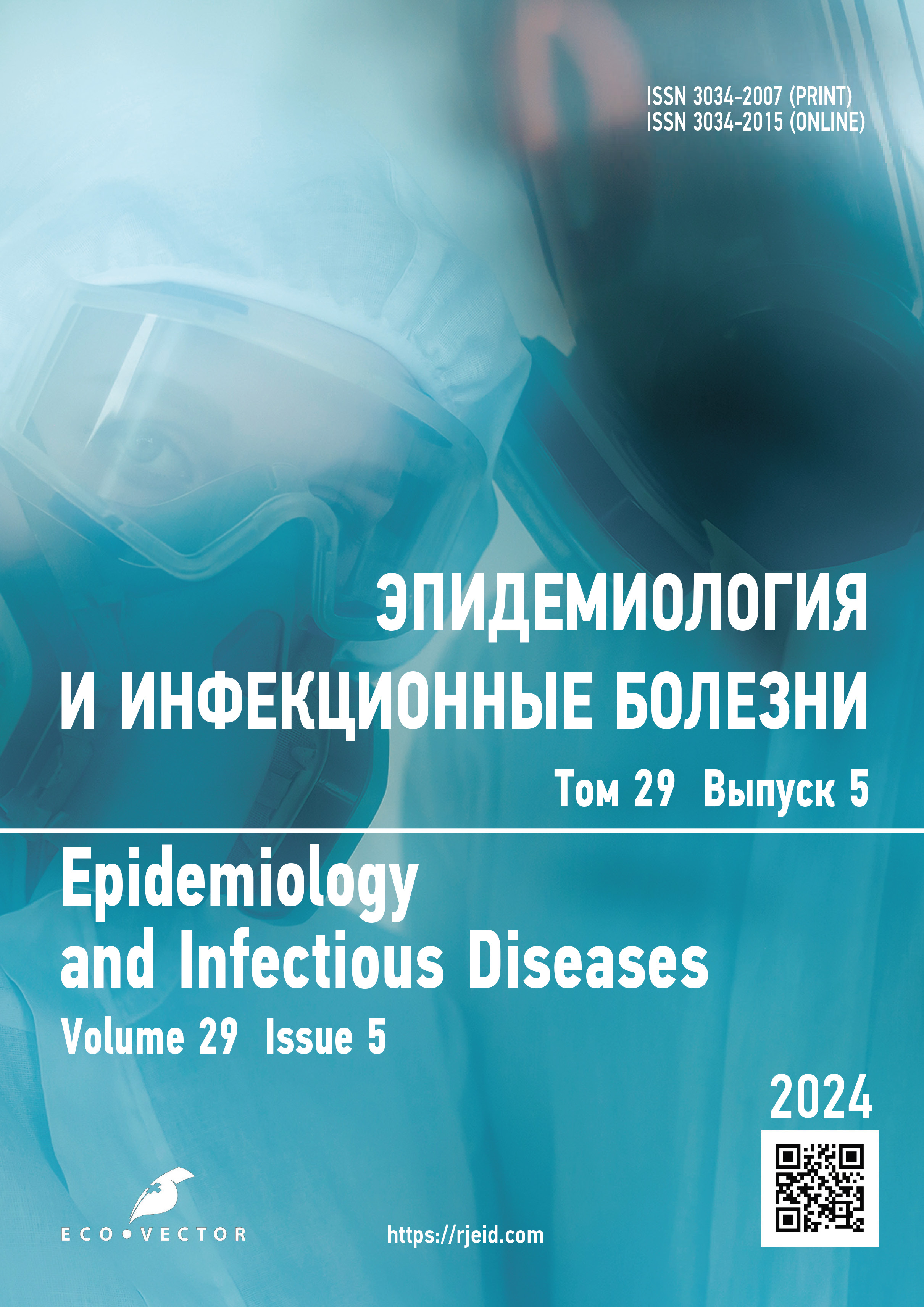Current situation with anthrax in Russian Federation
- Authors: Demaldinov V.D.1, Filyaev V.N.2
-
Affiliations:
- Astrakhan Anti-Plague Station
- Astrakhan State Medical University
- Issue: Vol 29, No 5 (2024)
- Pages: 393-402
- Section: Reviews
- URL: https://bakhtiniada.ru/1560-9529/article/view/290557
- DOI: https://doi.org/10.17816/EID636451
- ID: 290557
Cite item
Abstract
Anthrax is a zoonotic disease classified as a highly hazardous infection.
Until the mid-20th century, the capabilities of regulatory services were insufficient to prevent the emergence of new infection hotspots. Each year, mass livestock die-offs and human cases of this disease were recorded.
Public unawareness of the disease’s causes and the lack of proper disposal methods for deceased animals led to widespread soil contamination with anthrax spores across extensive territories of Russia, particularly in southern regions. The disposal of infected cattle and other animals involved the creation of burial sites. In practice, however, these often turned into “murrain fields,” where animal remains lay exposed. Only in the 1950s was there a shift toward ash-based burial methods for cattle.
The current state of monitoring for anthrax-affected sites and burial grounds, coupled with decreased oversight by veterinary services, does not exclude the possibility of animal and human anthrax cases. However, these cases are predominantly sporadic, appearing as outbreaks.
In Russia, anthrax-prone areas are monitored at multiple levels. Collected information is compiled into reference materials, facilitating differentiated planning of preventive measures based on regional characteristics.
The existing registry of anthrax-affected sites in Russia no longer meets current demands. Modern electronic databases and geographic information systems contribute to identifying common patterns of anthrax territorial distribution in Russia and understanding the persistence of activity in affected locations. These tools enable efficient data collection, analysis, and synthesis to prevent deterioration of the epizootiological and epidemiological situation.
Full Text
##article.viewOnOriginalSite##About the authors
Vadim D. Demaldinov
Astrakhan Anti-Plague Station
Author for correspondence.
Email: Hasan11693@gmail.com
ORCID iD: 0009-0008-0240-8014
MD
Russian Federation, AstrakhanVladimir N. Filyaev
Astrakhan State Medical University
Email: mpf@inbox.ru
ORCID iD: 0009-0002-2891-7577
SPIN-code: 6152-1460
MD, Cand. Sci. (Medicine), Assistant Professor
Russian Federation, AstrakhanReferences
- Cherkassky BL. Epidemiology and prevention of anthrax. Moscow: InterSEN; 2002. 384 p. (In Russ.) EDN: PBDIMZ
- Loktionova MN. Patterns of territorial distribution and activity of permanently affected areas of anthrax in the Russian Federation [abstract of the dissertation]. Moscow; 2011. 24 p. (In Russ.) EDN: QHPOMZ
- Cherkassky BL, editor. Cadastre of permanently disadvantaged anthrax settlements of the Russian Federation. Moscow: InterSEN; 2005. 829 p. (In Russ.)
- Veterinary and sanitary rules for the collection, disposal and destruction of biological waste No. 3-7-2/469 dated December 04, 1995. Available from: https://docs.cntd.ru/document/9015471 Accessed: 15 Jun 2024. (In Russ.)
- Shishkova NA, Tyurin EA, Marinin LI, et al. Modern State of the Anthrax Problem. Bacteriology. 2017;2(3):33–40. doi: 10.20953/2500-1027-2017-3-33-40 EDN: UQHMOU
- Simonova EG, Galkin VV, Loktionova MN, Ladnyi VI. Anthrax Cattle Burial Grounds in Russia and Their Biosafety. Journal of Microbiology, Epidemiology and Immunobiology. 2010;(4):23–26. EDN: NPNCFE
- List of animal burial grounds (including anthrax) located on the territory of the Russian Federation (Northwestern, Southern, North Caucasian Federal Districts). Moscow: Rosinformagrotech; 2011. 135 p. (In Russ.) EDN: QLCESN
- Analytical quarterly, cumulative report on the epidemiological situation in the country (according to the Department of Veterinary Medicine of the Ministry of Agriculture). The epizootic situation in the Russian Federation. Available from: https://fsvps.gov.ru/jepizooticheskaja-situacija/rossija/analiticheskij-ezhekvartalnyj-s-narastajushhim-itogom-otchet-po-jepidsituacii-v-strane-po-dannym-departamenta-veterinarii-msh/ Accessed: 15 Jun 2024. (In Russ.)
- Ryazanova AG., Skudareva ON., Gerasimenko DK., et al. Analysis of the situation of anthrax in 2022 in the world, forecast for 2023 in the Russian Federation. Problems of Particularly Dangerous Infections. 2023;(2):88–94. doi: 10.21055/0370-1069-2023-2-88-94
- On the sanitary and epidemiological situation in the Russian Federation in 2008: state report. Moscow: Federal’nyy tsentr gigiyeny i epidemiologii Rospotrebnadzora; 2009. P. 331–332. Available from: http: //rospotrebnadzor.ru/documents/ros/doclad Accessed: 15 Jun 2024. (In Russ.)
- Kulichenko AN, Buravtseva NP, Ryazanova AG, Eremenko EI. Anthrax in the North Caucasus. Maikop: Kachestvo; 2016. 198 p. (In Russ.) EDN: WJYGXP
- Popova AYu, Demina YuV, Yezhova EB, et al. Outbreak of Anthrax in the Yamalo-Nenets Autonomous District in 2016, Epidemiological Peculiarities. Problems of Particularly Dangerous Infections. 2016;(4):42–46. doi: 10.21055/0370-1069-2016-4-42-46
- Anthrax and its epidemiological situation in the Russian Federation in 2023. Available from: https://gigiena-saratov.ru/tpost/d4crr4ofb1-sibirskaya-yazva-i-ee-epidemiologicheska Accessed: 15 Jun 2024. (In Russ).
- Resolution No. 45 dated 29.03.2017 “O vnesenii izmenenii v sanitarno-epidemiologicheskie pravila SP 3.1.7.2629-10 “Profilaktika sibirskoi yazvy”, utverzhdennye postanovleniem Glavnogo gosudarstvennogo vracha RF ot 13.05.2010 № 56”. Available from: https://www.garant.ru/products/ipo/prime/doc/71643862 Accessed: 15 Jun 2024. (In Russ.)
- Logvin FV., Kulichenko AN., Ryazanova AG., et al. Anthrax in the South of Russia. Medical Herald of the South of Russia. 2024;15(2):126–134. doi: 10.21886/2219-8075-2024-15-2-126-134
- Ryazanova AG, Semenko OV, Buravtseva NP, et al. Study of the features of the territorial distribution of permanently unfavorable areas for anthrax and its burial sites in the Astrakhan Region, by using GIS technologies. Epidemiology and Infectious Diseases. Current Items. 2021;(2):83–88. doi: 10.18565/epidem.2021.11.2.83-8
- Passport of the territory of the joint-stock company. The zones are unfavorable in terms of sanitary and epidemiological indicators. Available from: https://30.mchs.gov.ru/uploads/resource/2021-08-16/riski-vozniknoveniya-chs-biologo-socialnogo-haraktera_16291125631126667291.pdf Accessed: 15 Jun 2024. (In Russ.)
- Letter of the Veterinary Service of the Astrakhan region No. 301-06 a/4972 dated 09/13/2024 to the request of the Federal Institute of Emergency Situations of the Rospotrebnadzor in the Astrakhan region No. 30-0-01/01-21-677-2024 dated 08/29/2024. 3 p. (In Russ.)
Supplementary files










